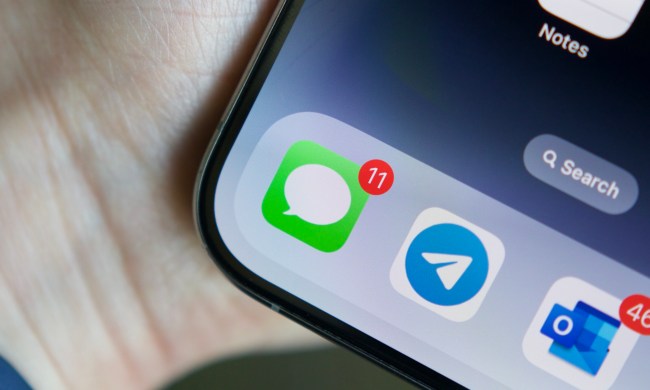Virtual reality (VR) has long been the “just around the bend” technology that has promised more than it has delivered. The Oculus Rift has arguably done more to dissolve that reputation than anything else in recent memory, but a startup in Toronto thinks it has a better idea: Use smartphones instead of standalone headsets.
Pinć (pronounced “pinch”) is a platform made up of both an app and an inexpensive headset that can double as a case. Placing an iPhone 6 or 6 Plus inside and running the app, a user can interact with supported features and functions through an immersive interface.
The name is a play on the pinching hand gestures required to interact with the VR world; users must wear a motion-detection ring on each index finger to browse and interact. This is slightly new territory for the small group at Cordon Media, which has been in business since 2008 as an app developer and website designer for various clients. With no hardware pedigree behind it, the purpose isn’t to bill Pinć as a smartphone accessory, but more as a VR platform built around one.
The result seemed like a cross between Minority Report and an airplane cockpit.
“It’s like an operating system on top of an operating system (iOS); sort of like its own ecosystem,” explains Milan Baic, president at Cordon. “The state of VR today is a very dedicated and niche experience, especially for gaming. We’re trying to make it mainstream by using the devices people already have in their pockets.”
The way Baic sees it, VR has “three big issues” that Pinć is meant to address. First, a controller or joystick is an awkward way to work in three dimensions, so Pinć uses gestures. Second, a standalone headset is hefty and limiting, so Pinć uses your phone. Third, VR has traditionally been confined to mostly games and movies, so Pinć is focusing on e-commerce.
To be clear, Baic isn’t suggesting Pinć can topple the likes of Oculus Rift. Far from it. His point is that it shouldn’t take a separate device to create an immersive VR experience when the computational power of today’s mobile devices can do the job.
Why e-commerce? “VR allows you to create an experience, and if you couple that with an intuitive way to interact with that environment, you can create a virtual storefront, mimicking the experience of brick-and-mortar. We think that’s really what people want,” he says. “It’s bringing the low-cost shop concept of digital consumption with the advantages of the brand experience you would have in person.”
For the moment, it’s hard to prove that with a still-rudimentary proof of concept that currently has no retail partners. The 3D-printed headset shown to us was over 20mm thick, though Baic says the finished product will shed half that girth with because of the thinner left and right eye lenses that will be used. Though still very light, the next version will trim some weight, too. The adjustable band wrapping around the head will retract to negate clutter. A rear lens will widen your phone’s camera angle to capture more motion. All ports on the phone are accessible, and there are plans to integrate earbuds into the handles in the final design. The index finger “pinchers” we saw were also magnetic latch prototypes powered by watch batteries, but we’ve been assured those will be much better-looking when crafted as rings.
The overall final package will have to be, now that the Pinć Indiegogo campaign has gone live with a $100,000 goal. Pre-orders will go for $99, and through the release of the SDK being called “Discovery Edition”, the hope is that early adopters and developers will tinker with it. Three apps are provided initially — a VR Web browser, a video client integrated with YouTube, and an e-commerce front-end, purely for testing. Ideally, Cordon would like to integrate with a third-party like Amazon or Shopify to handle the backend infrastructure for that, but there’s no word yet on how such a deal might get done.
Limiting things to the two latest iPhones is also a good testing ground, Baic says. If the campaign goes well and the interest is there, his team will look at doing it all for Android, despite the fragmented adoption of the popular OS.
We just don’t see VR being delivered to the mainstream in any other way.
Like Pinć’s rough physical build, the software itself is also very much in alpha stage. While Baic strapped himself in for a demo, we watched what he was looking at on a monitor in real-time. There was lag, stuttering and a few other bugs, but the result seemed like a cross between Minority Report and an airplane cockpit. The whole environment can be enlarged or shrunken using a pinch to zoom command. The larger it is, the more you would have to look around to access different features on the main interface. Part of the reason for this design is to make it easier to view prospective purchases in a more interactive way.
Of course, using a smartphone as the main vehicle to a VR world isn’t new. Samsung’s Gear VR does the same thing with a Galaxy Note 4, though the main focus there is on using it as a gaming platform. There’s also Google Cardboard, and some other ongoing Indiegogo projects that are aiming to bring VR to the iPhone as well. Baic thinks the big differentiator here is going to be Pinć’s mainstream appeal and e-commerce integration.
“We just don’t see VR being delivered to the mainstream in any other way,” he says. “From a price point and technology standpoint, we’re not trying to reinvent the wheel and invent another device when the one in your pocket can be expanded to do even more.”
Those curious enough to plunk down the $99 to find out will have to wait until the spring of 2015 when they roll out.







